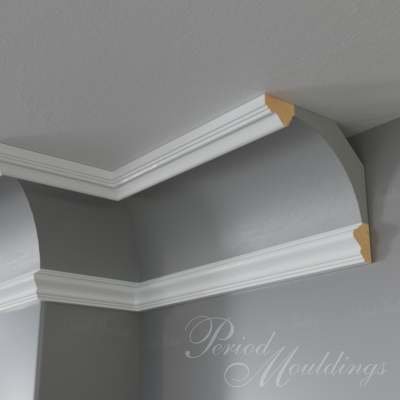Before homes were hastily built against tight budgets and deadlines, architectural gestures came in the form of cornices, mouldings, fraises and ceiling roses, and these were a feature of houses predominantly in the Georgian, Victorian and Edwardian eras. Some of these features are still visible in period properties today, but the practice of incorporating ceiling mouldings in modern homes is sadly a lost art.
Using plasterwork to create period features can generally be confined to these three periods mentioned. These are often referred to as the ‘classic’ periods of architecture and have been proceeded by many 20th century styles such as art deco, brutalism and post-modernism, but none of these paid special attention to ceiling mouldings.
The ‘classic’ eras of ceiling mouldings
Existing homes around the UK – and particularly in London – are still displaying original ceiling mouldings, which tend to be in the Georgian, Victorian or Edwardian style. The term ‘classic’ really refers to each era’s nod to ancient Greek architecture – ie. true classicism – but it is true that whilst they look ‘period’ and ‘dated’ now, they were all avant garde for their time and closely reflected society.
Although eras always merge and share close similarities in design styles, Georgian mouldings originate from the 1714-1830 period. This era can count Number 10 Downing Street amongst its most notable achievements. Georgian houses were largely symmetrical with high ceilings but flat or shallow roofs. Ceiling mouldings were constructed from gypsum plaster reinforced with timber, and some plasterers of the time would craft details out of papier-mache or a paper-based compound known as ‘compo’. These stood the test of time but would dissolve if you tried to clean them with water or other chemical cleaning solutions.
Victorian architecture comes from the period 1837 to 1901 and takes some of the Georgian influences – columns and proportions – but also introduced Gothic revival and renaissance features. There was vast societal change in Britain in the Victorian era, with the wealth created by the industrial revolution bringing different styles spanning the start and end of the period. Porches, bay windows, external terracotta tiles and elaborate interior decoration was introduced as wealth spread down the traditional class system.
The evolution of ceiling mouldings
Ceiling mouldings were constructed in the same way as in Georgian times, but in this period ‘distemper’ paint – a paint combination of whiting and glue – was extensively used to provide a clean ceiling covering but also to fill minor cracks and give a smooth surface. This was fine, until the Victorians slapped layer after layer on to cover up the effects of gas and oil lamps burning on the ceiling, and now the fine period detail is lost, obscured and hard to restore and the old surfaces are difficult to paint over.

The shorter Edwardian period – 1901 to 1918 – incorporated World War l and hence it was no time for elaboration. However, the increasing populations had given rise to the suburbs and more ‘modern’ housing, with that came an eclectic mix of influences. Electric lighting also changed internal architecture with less door and window architrave, and decorative patterns were less embellished. In terms of ceiling mouldings, lines were straighter and more clinical, perhaps a natural progression to today’s minimalist styling, although flowers were very much still in fashion and ceiling roses and other floral designs could still be found on the nation’s ceilings.
You can research and discover more about the different eras of wall and ceiling decoration with Period Mouldings, and see immediately how each style has significant but subtle differences. Take a look at our ceiling moulds on our website today and discover the wealth of history in our ceiling mouldings.

